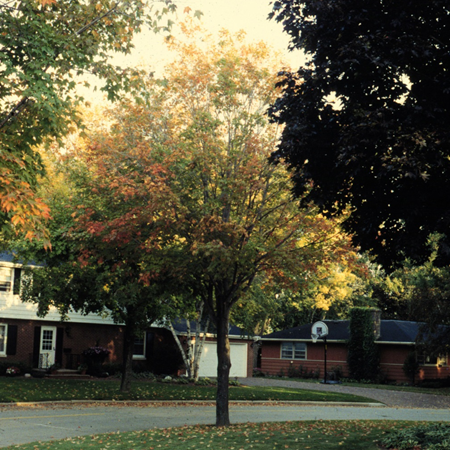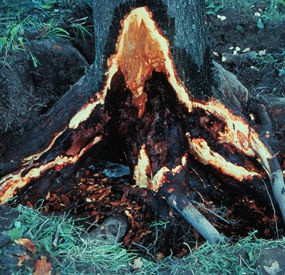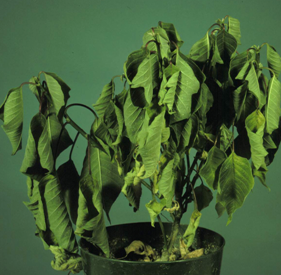
What is root/crown rot?
Root/crown rot is a general term that describes any disease of woody ornamentals where the pathogen (causal organism) attacks and leads to the deterioration of a plant’s root system and/or lower trunk or branches near the soil line. Root rots can be chronic diseases or, more commonly, are acute and can lead to the death of the plant.
What does root/crown rot look like?
Gardeners often become aware root/crown rot when they see above ground symptoms. Affected plants are often slow-growing or stunted and may show signs of wilting. Often the canopy of an affected tree or shrub is thin, with foliage that is yellow or red, suggesting a nutrient deficiency. Careful examination of the roots/crowns of these plants reveals tissue that is soft and brown.
Where does root/crown rot come from?
Several soil-borne water molds (i.e., fungi-like organisms) and true fungi can cause root/crown rots, including (most frequently) Phytophthora spp. and Pythium spp. (both water molds), and Rhizoctonia solani and Fusarium spp. (both true fungi). These organisms have wide host ranges, and prefer wet soil conditions. Water mold root rot organisms such as Pythium and Phytophtora produce thick-walled spores (called oospores) that can survive for long periods (years to decades) in soil.
How do I save a plant with root/crown rot?
REDUCE SOIL MOISTURE! Provide enough water to fulfill a plant’s growth needs and prevent drought stress, but do not over-water. Remove excess mulch (greater than four inches) around trees and shrubs. Excessive mulch can lead to overly wet soils.

Chemical fungicides (e.g., PCNB, mefenoxam, metalaxyl, etridiazole, thiophanate-methyl and propiconazole) and biological control agents (e.g., Gliocladium, Streptomyces, and Trichoderma) are labeled for root/crown rot control. However, do not use these products unless you know exactly which root/crown rot pathogen(s) is(are) affecting your trees and shrubs. Contact your county Extension agent for details on obtaining an accurate root/crown rot diagnosis and for advice on which, if any, fungicides you should consider using.
How do I avoid problems with root/crown rots?
Buy plants from a reputable source, and make sure they are root/crown rot-free prior to purchase. Establish healthy plants in a well-drained site, and when planting, place the root collar just at the soil surface. To moderate soil moisture, add organic material (e.g., leaf litter or compost) to heavy soils to increase soil drainage, and do not over-water. Also, do not apply more than three inches of mulch around trees and shrubs, and keep mulch from directly contacting the base of trunks and stems. Prevent physical damage (e.g., lawnmower injury) that can provide entry points for root/crown rot pathogens. Finally, minimize movement of root/crown rot fungi in your garden. Do not move soil or plants from areas where plants are having root/crown rot problems. Do not water plants with water contaminated with soil (and thus potentially with root/crown rot organisms). After working with plants with root/crown rot, decontaminate tools and footwear by treating for at least 30 seconds with a 10% bleach solution or 70% alcohol (e.g., rubbing alcohol, certain spray disinfectants). If you use bleach to decontaminate metal tools, be sure to thoroughly rinse and oil your tools after you are done gardening to prevent rusting.
For more information on root/crown rots:
Contact the University of Wisconsin Plant Disease Diagnostics Clinic (PDDC) at (608) 262-2863 or pddc@wisc.edu or read Maple Decline: Collar Rot and Basal Canker Complex.
Authors: Brian Hudelson, UW-Madison Plant Pathology and Laura Jull, UW-Madison Horticulture
Last Revised: 03/01/2024
D-number: D0094
References to pesticide products in this publication are for your convenience and are not an endorsement or criticism of one product over similar products. You are responsible for using pesticides according to the manufacturer’s current label directions. Follow directions exactly to protect the environment and people from pesticide exposure. Failure to do so violates the law.
Thanks to Karen Delahaut, Ann Joy and Sharon Morrisey for reviewing this document.
A complete inventory of UW Plant Disease Facts is available at the University of Wisconsin-Madison Plant Disease Diagnostics Clinic website: https://pddc.wisc.edu.
Send a Plant Sample for Analysis
Be cautious when self-diagnosing plant health issues. Very few diseases can accurately be diagnosed by eye.
Contact the UW Plant Disease Diagnostics Clinic (PDDC), and for a small fee, clinic staff can examine a plant, determine the cause of the disease/disorder, and provide advice on how to control or prevent the issue.
Download Article





 Armillaria Root Disease
Armillaria Root Disease Root and Crown Rots
Root and Crown Rots Root Rots in the Garden
Root Rots in the Garden Root Rots on Houseplants
Root Rots on Houseplants


